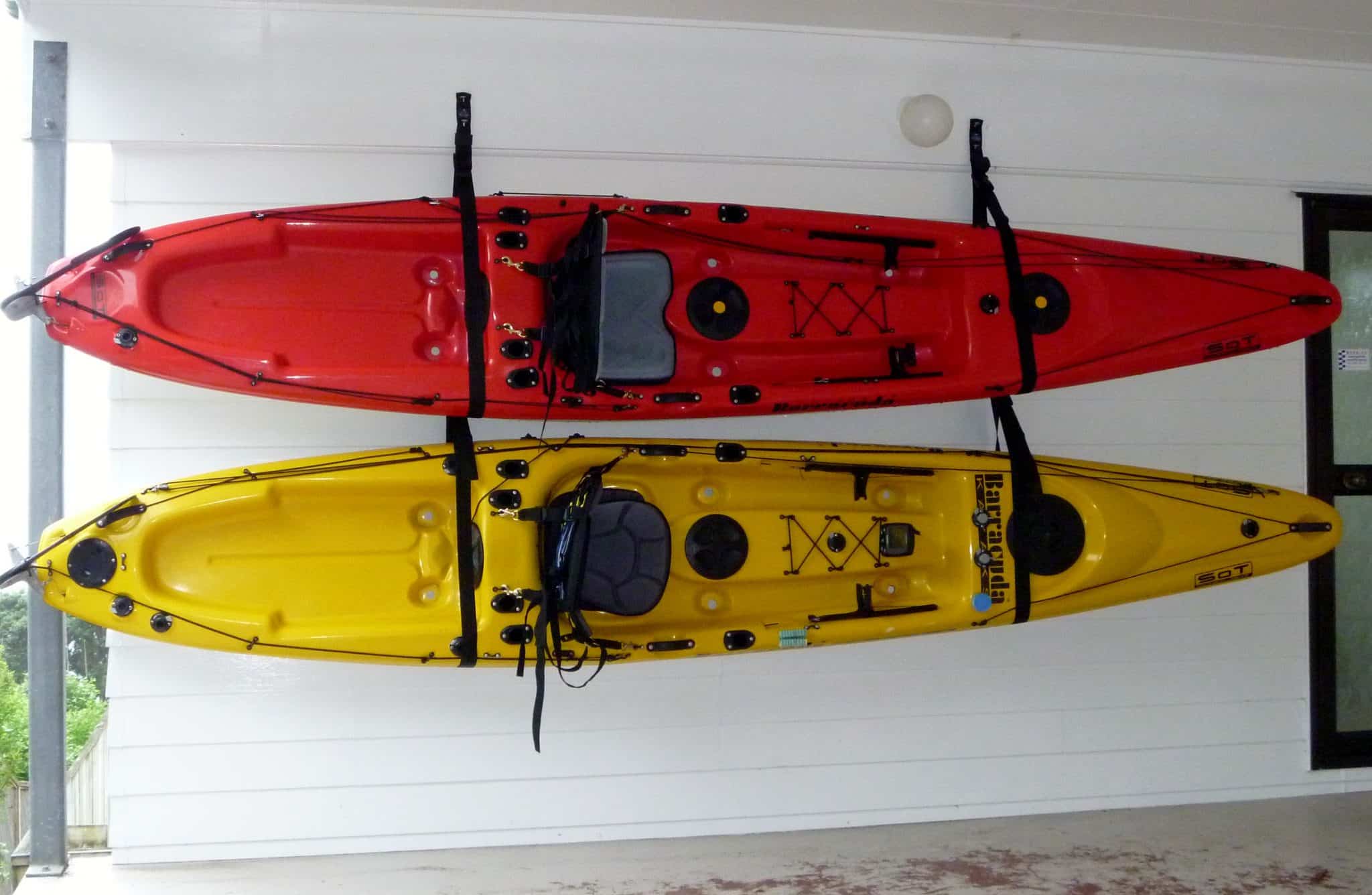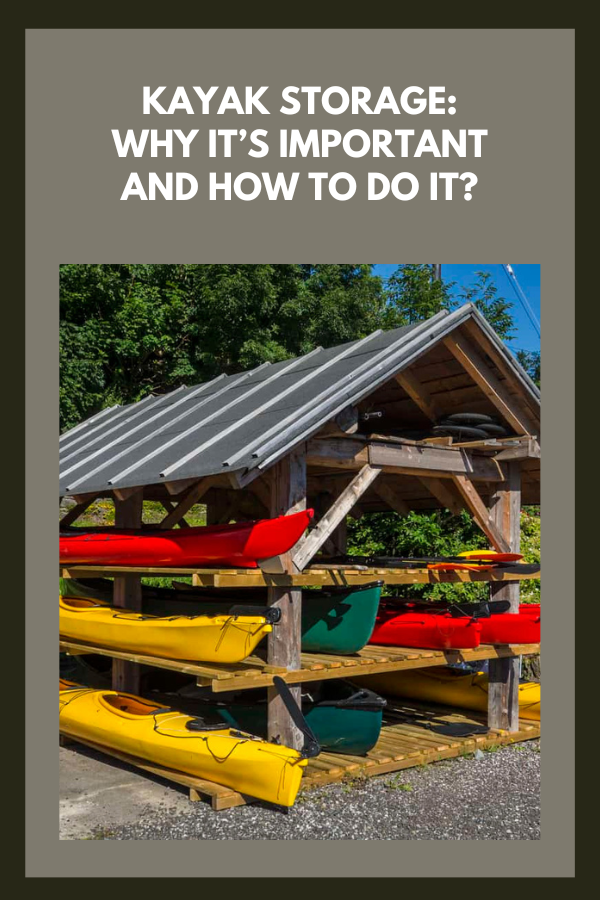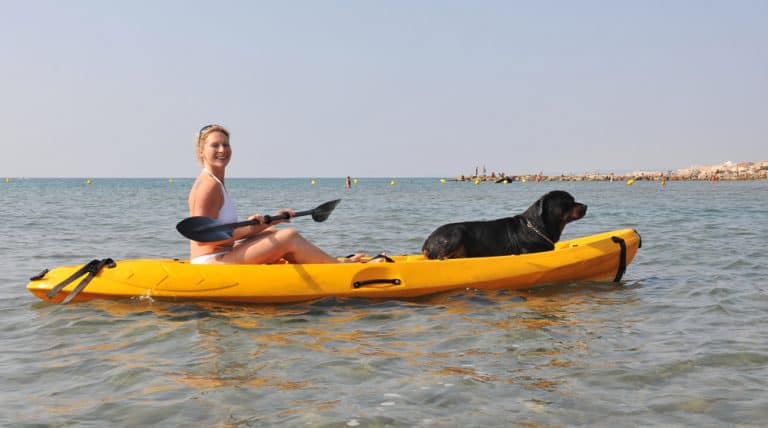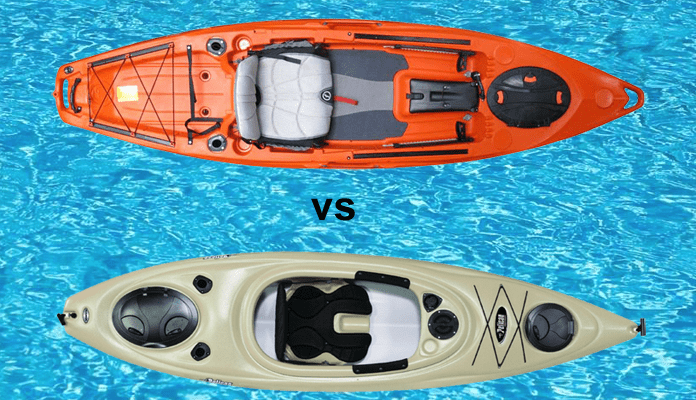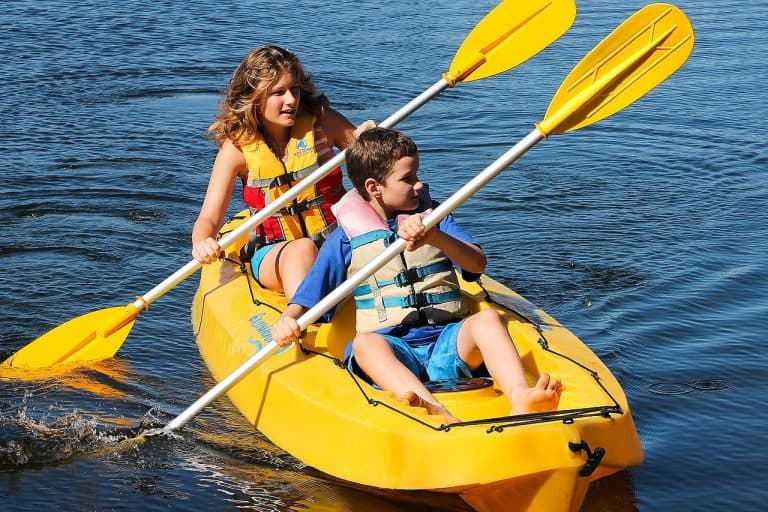Imagine a picture perfect sunny day. Finally, the beginning of the kayaking season has arrived. The sun is shining above a gentle late-spring breeze, and the crisp, cold water in which your adventure will begin is beckoning your name.
To pay homage to this gorgeous day, you decide to take your kayak out for a spin. You walk into the room, garage or shed in which your kayak has been patiently awaiting your return all winter.
You reach for your kayak and, to your shock and horror, you notice a large split in its fiberglass foundation, a split that was not present when you last stored your kayak away in late autumn.
This is what can happen when your kayak is improperly stored. And it happens more frequently than you might think.
To help you avoid a similar fate with your kayak, below we’ll provide an in-depth guide for storing a kayak. In the first part, we include a list detailing some of the reasons to store your kayak properly, followed by a series of helpful tips on how you can protect your kayak from wear, damage, deformity and even theft through correct storage.
By following some of the expert advice and storage solutions we have culled through our extensive research, you’ll be able to greet the water adventure calling you.
Part One: Four Reasons to Store a Kayak Correctly
Kayaks are an expensive investment. Because of this, there are many reasons to store a kayak properly in order to protect that investment. In the following section we will outline four of those reasons in great detail that include:
1. Protecting your kayak from damage or deformity, 2. Protecting your kayak from the rain, wind, snow and other elements, 3. Protecting your kayak against potential theft, and 4. Protecting your personal safety.
1. Protecting Your Kayak From Damage or Deformity
Kayaks stored incorrectly can lead to severe damage and cause deformity or distortion to the boat’s hull. According to experts, when storing a kayak, you must distribute the weight evenly.
Failing to do so can cause the hull of the kayak to bend or deform, with the extra weight pressing down on the kayak acting as the primary deforming agent. Of course, this distortion may not be apparent immediately, but when you consistently store a kayak with the weight distributed unevenly, eventually distortion is not only possible, but probable.
Storing your kayak on its hull is usually the main culprit for uneven weight distribution, as this places abnormal pressure on the part of the kayak contacting the ground or other storage surface.
When the hull of the kayak is forced to absorb the brunt of the weight during storage, it will gradually begin to alter the shape of the hull.
This, in turn, can cause performance issues during use, as it actually alters the manner in which the kayak is supposed to glide through the water, making you work harder for the same results when paddling.
In addition to the damage that can be caused when storing a kayak on its hull, there are several other storage practices that can cause damage or deformity to the boat. Some of these include:
Standing the Kayak on End
Standing the kayak on end can cause the same type of damage and distortion as when you place it on its hull. By doing this, you are putting undue pressure on one end of the boat, which can cause cracks to form in the kayak and may even deform the shape of the bow or stern.
Standing a kayak up is also very dangerous because it increases the chance that it can tip over and become damaged, or even worse, hurt a child or pet playing nearby.
Hanging the Kayak From its Grab Handles
The grab handles or straps on the kayak are designed for carrying the kayak only. Yet there are many people who elect to store their kayak by hanging it from these handles.
Over time, hanging a kayak from its grab handles can weaken those handles, causing them to erode or break. And without these handles, transporting a kayak from your vehicle to the water can be very difficult.
Supporting the Kayak on the Bow and Stern Only
It may seem logical to hang your kayak in a way that merely supports the bow and stern. But when a kayak is hung supporting only the bow and stern, the weight from the middle of the kayak can, over time, start to change the shape of the hull. This, as you remember, can cause performance issues in the water.
Storing on Hard Flat Surfaces
Even if you plan to store your kayak upside down, placing it on a hard flat surface is never a good idea, as the various contact points (where the kayak meets the hard surface) can become scratched or dented.
So what types of kayaks are prone to distortion caused by improper storage? All of them are.
While kayaks with plastic hulls are the most prone to distortion and damage, over time, even those kayaks made from composite material and wood can become deformed due to improper storage.
Inflatable kayaks can also become damaged during storage. To avoid this, the best practice is to deflate and disassemble the kayak just prior to storing it.
Although we will cover this more in the next section focused on how to properly secure and store your kayak, the best practice for kayak storage is to support the kayak at several spots along its entire length.
2. Protecting Your Kayak From the Elements
Kayaks, whether they are made of wood, plastic, fiberglass or some other composite material, can quickly or gradually become damaged by all sorts of elements, including rain, wind, heat, cold,frost sunlight and saltwater.
Below we’ll look at some of the main culprits of damage in terms of weather and other elements, and the havoc that each can cause your prized kayak.
Sunlight
According to experts, sunlight can gradually degrade almost any type of material, including wood, plastic and even fiberglass.
Because of this, it is crucial that you store your kayak in such a way that it avoids direct sunlight. Naturally, the best way to do this is to store your kayak indoors, such as in a basement or garage, but when that is not possible, there are a couple of things you can do, including:
Use a Tarp
If you must store your kayak outside, a tarp can help keep it protected from the elements. However, when using a tarp to cover your kayak, it’s important that no part of the tarp is actually touching the boat.
That’s because contact between an outdoor tarp and the kayak can cause mold and fungus, both of which can ruin your water-going vessel. Instead, place the kayak under a suspended tarp, being extra careful that the entire boat is out of the sunlight.
Use Sun-Protective Spray
Sun-Protective spray can help protect your kayak from the damaging ultraviolet (UV) rays of the sun. This spray should be used twice a year at minimum. Once when you take your boat out of storage for the kayak season, and again when you pack it away.
Remember to cover the entire boat, including the inside portion of the hull.
Cold and Frost
Another great reason for storing your kayak in a temperature-controlled building is to protect it from freezing temperatures and frost. Extremely cold temperatures can wreak havoc on a kayak, even when it is stored inside.
Kayaks have a number of creases and crevices, places where water can seep in and settle. Normally this is not a problem, but when the kayak is exposed to freezing temperatures, this causes that water to freeze.
In turn, this leads to an endless process of contraction and expansion that can damage the kayak over time. For this reason, the most ideal situation is to store the boat at room temperature.
Rain and Snow
If you must store your kayak outside, it’s important to take extra precautions during the rainy and snow seasons. Water that collects on and in your kayak can cause mold to grow over time, which, as we explained above, can quickly ruin your kayak.
Tarps can protect your kayak from the rain and snow, but it’s important to check on your boat from time to time to ensure no water has leaked from the tarp onto the boat.
Saltwater
Another enemy to the integrity of your kayak is saltwater. Salt can degrade the exterior of all kinds of kayaks (wooden, plastic, composite, fiberglass, etc.) and the metal parts within your boat as well.
Therefore, if you plan to use your kayak in the ocean, it is imperative that you thoroughly spray the boat down with fresh, clean water after each use.
Be sure to also spray the inside and bottom portions of the kayak. Also, if you live in a seaside area where there is a lot of salt in the air, it’s important to spray the boat down regularly to avoid damage, degradation and corrosion.
By protecting your kayak from the elements you can keep it in tip-top shape for years to come.
3. Protecting Your Kayak Against Theft
As we mentioned in an earlier section, your kayak is an investment in money, fun and adventure. Your kayak can provide hours of fun and excitement thrills that can be cut off if your kayak falls into the hands of a thief.
So how do you protect your kayak against potential theft? Here are some basic things to keep in mind.
If you plan to store your kayak for an extended period of time, such as throughout the cold and rainy winter season, chances are you won’t be checking up on your kayak on a regular basis, and this can be a recipe for potential theft.
If you won’t be checking up on your kayak, it’s important that you keep it hidden in a locked facility that only you and those you trust have access to. Locks are a great way to deter thieves and will give you peace of mind knowing your kayak is safe.
If for some reason it is not possible to keep your kayak inside a locked facility, try keeping it as hidden away as possible.
Thieves tend to be in a hurry when plying their evil craft, and they usually stick to items that are in plain sight. Keeping your kayak hidden and difficult to reach can therefore be a great deterrent.
Finally, there is one additional security measure you should consider when your kayak will be out of sight for a lengthy period of time: a locking cable.
Locking cables, like the ones used to secure boats to docks or piers, are almost impenetrable to the everyday thief. When locking your kayak using one of these cables, be sure to secure the boat to something solid, like a steel pole, a heavy workbench or some other permanent structure.
This will discourage thieves and protect your kayak for many more years of boating fun and excitement.
4. Protecting Your Personal Safety
The final reason to store your kayak properly is to ensure the safety of you and others. Depending on its makeup, kayaks can range in weight from 50 to a couple hundred pounds, which means they can easily cause injury if they are not stored suitably.
Kayaks left leaning up against a wall, for example, can fall and injure someone, and those suspended above using less-than-secure methods can drop and create a very hazardous situation.
In the next section we will cover some tips on how exactly to store a kayak to protect against damage, deformity, the elements, theft and accidental injury.
Part Two: Expert Tips for Appropriately Securing and Storing Your Kayak
Kayaks can offer recreational enthusiasts a lifetime of peaceful and exhilarating water adventures, from cruising on the quiet and glass-like waters of your favorite lake, to shooting fast-moving rapids that demand your utmost focus and attention.
By storing your kayak properly, you avoid transforming your fun water-going vessel into nothing more than a yard decoration. But just how do you go about accomplishing this very crucial task?
In this section we will answer that question thoroughly, relying heavily on tips and advice we have compiled from some of the most premier kayak experts.
Five Inside Storage Solutions for Your Kayak
Storing a kayak indoors is always your best bet, as it protects your vessel against damaging sunlight, rain, frost and other climatic conditions that can harm it.
However, just putting your kayak inside is not enough to protect it from damage or deformity. To make sure the weight of your kayak is supported correctly when storing your kayak indoors, try these storage solutions:
1. Seahorse Storage
A Seahorse is an aftermarket storage system that is very popular among kayak enthusiasts.
Designed to properly support the weight of the kayak, this covered storage container not only supports the kayak in the proper way, it also folds up when not in use to keep it from taking up too much space in your garage or basement.
2. Overhead Pulley System.
Overhead pulley systems, which allow your kayak to be stored up and out of the way, are readily available for purchase. These systems come with all the hardware you need to safely hang and fully support your kayak to avoid warping or deforming the hull of the boat.
3. Web Sling
As we mentioned in the first section, one of the best ways to store your kayak is with mesh nylon webbing that conforms to the shape of your kayak.
Not only does a web sling ensure that the weight of the boat is distributed evenly, it is also a great space-saving solution because it is overhead and out of the way.
4. Wooden Racks
There are many companies that make wooden racks designed to store one or more kayaks. These “J Racks” are great when you need easy access to your kayak on a regular basis hey are also superb at supporting the kayak.
Although not as space-saving as the overhead pulley system or web sling, they may be well worth the investment if space is not an issue. Blueprints for these “J Racks” can be found online if you prefer to make your own rack rather than purchasing one.
5. Car Racks
The roof racks you use during kayak season to transport your boat can also be used to store your boat in the off season. Car racks can either be placed on the ground or, to save space, you can mount them on the wall of the garage.
Three Outdoor Storage Solutions for Your Kayak
Although inside storage should always be pursued as your first option, if you must store your kayak outside, here are some solutions:
1. Heavy Duty Tarps
When using a heavy duty tarp system to protect your kayak, your best bet is to build an area with tarps on each side and above the kayak. This will protect it from the damaging rays of the sun and moisture that can cause mold and fungus growth.
2. Wooden Enclosure or ack
There are plans and blueprints all over the Internet on how to build an outdoor, dog house-like rack enclosure for your kayak. This enclosure will not only protect it from the elements, but also from damage and deformity, making sure it is supported correctly.
3. Seahorse
If you opt to purchase the Seahorse storage solution, this weather-resistant case can be used outside, either under a tarp or in a wooden enclosure. It will support your kayak properly and protect it from the damaging rays of the sun and other climatic conditions.
Conclusion
Damage, deformity, degradation, theft and personal injury are all things you risk when you fail to store your kayak properly, which puts your investment and safety in harm’s way.
To avoid these maladies, follow the expert tips we have provided here for appropriate storage. In doing so, you can forever be sure your kayak is in excellent condition and patiently awaiting your next big water adventure.

